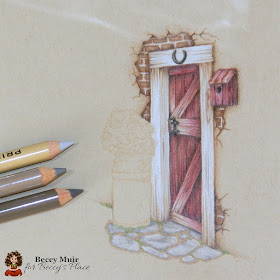Today's tutorial is all about colouring old, painted wood and I'm using one of my favourite stamps as an example - the rock framed door from the new Welcome Home set. You could use this technique on any wooden object from old furniture to painted row boats.
I stamped the image in a light coloured ink on smooth card stock, then added a very light layer of brown pencil to the wooden door. Even though my door won't end up brown, it will give me the undertone I'm looking for and provide me with a base for additional colours.
I'm using the same brown pencil to accentuate the knots in the wood and some of the larger cracks.
Now for the first layer of "paint". I want to end up with a lovely aqua door, but I also want it to be aged with time, use and the effects of the weather. If I simply colour the whole thing in one colour it will look flat and won't tell a story... so like a delicious parfait, we layer.
Working one plank at a time will give a more realistic look to your door. Each plank will be slightly different, tricking the eye into seeing them as separate pieces, which is exactly what we're after. I'm using a light aqua pencil to add a layer of colour to the first plank, avoiding the area around the knot. You often see old wood with lots of discolouration around knot holes, so I'm going to keep most of the "paint" away from that area and allow the under colours to show through. Don't be tempted to colour the wood brown though... old wood is actually more grey than brown.
Adding a bit more pressure with the same pencil will add more vibrancy to the colour. The paint will be more intense at the top of the plank where it has been shaded from the effects of the sun by the overhanging rock, so that's where you want to intensify the colour.
A darker shade of aqua adds even more intensity to the colour, but add it in light layers until you get the effect that you're after.
I'm going to colour the second plank in the same way, being mindful about weathering and human interaction. The paint around the door handle would have been worn away by decades of people opening and closing the door. Similarly, the paint around the bottom of the door would be a lot more worn from sun and water damage.
Intensify the colour with a darker pencil, applying less and less pressure as you move outward. Remember, blending pencil is all about the amount of pressure you use - less pressure will give you less pigment and therefore a lighter colour.
Work through all the planks in the same way until your door is coloured. Don't be afraid to leave lots of patches to give your door an old, weathered look.
I'm using a very dark brown pencil to add in some of the detail in the knot of the wood, around the door handle, between the boards, at the bottom of the door and in the cracks of the wood. Sharpen the pencil constantly to keep a nice fine tip for thin, sharp lines.
I'm adding more dark aqua between each board where the paint wouldn't be as affected by water and sun.
Again with the dark brown pencil to reinforce the cracks and gaps in the wood.
The door handle and hardware are coloured with dark greys and black to give the impression of metal. Add shadows to help define the ring on the door handle and the screws in the hardware.
And that's it, your door is done! Here's a colour chart of the pencils I used to colour the door. I'll continue using these same colours throughout the rest of the project to help bring everything together. Keep scrolling down for a step-by-step photo sequence of how I coloured the rest of the scene.
Here's a photo sequence for the remainder of the colouring:
Stamps:





















































